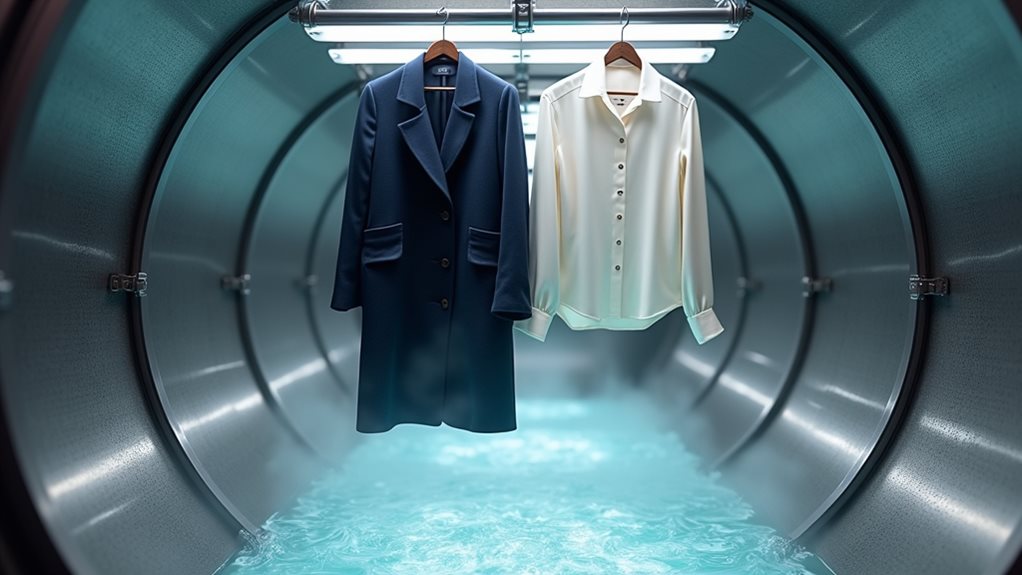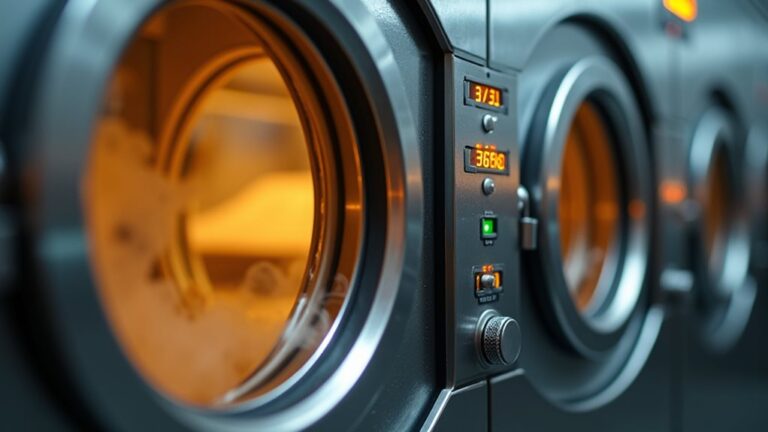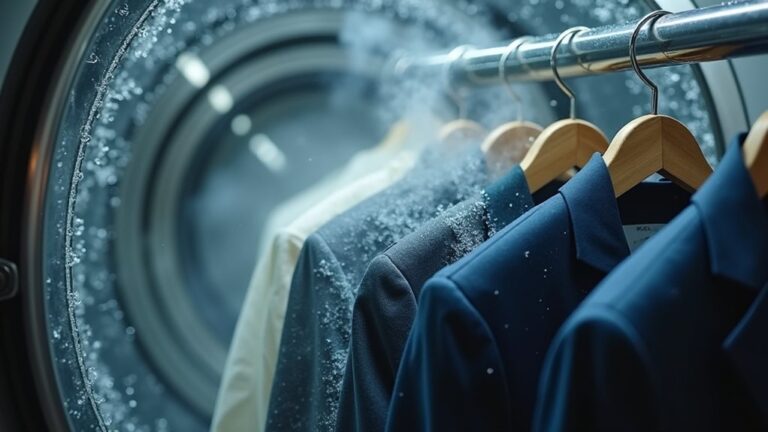When you drop off that silk blouse or wool suit, dry cleaning works by bathing your garments in specialized chemical solvents instead of water, gently dissolving oils and stubborn stains that regular washing can’t tackle. The process starts with inspecting your clothes, pre-treating visible spots, then circulating solvents through large machines that clean and dry simultaneously. This method preserves delicate fabrics‘ texture and shape while eliminating bacteria through high heat, guaranteeing your treasured pieces emerge refreshed and professionally maintained—though understanding which fabrics truly need this specialized care can save you both money and disappointment.
What Is Dry Cleaning?
When you’ve accidentally spilled red wine on your favorite silk blouse during a dinner party (trust me, we’ve all been there 😅), you’ll quickly discover that throwing it in your washing machine isn’t exactly the brilliant solution you’d hoped for.
That’s where the dry cleaning process becomes your fabric’s best friend, using specialized solvents instead of water to gently lift away stains and dirt. The solvents used in dry cleaning, particularly perchloroethylene, work like magic on delicate fabrics that would otherwise shrink, fade, or lose their shape in regular wash cycles.
Think of it as giving your precious garments a spa treatment rather than subjecting them to the rough-and-tumble world of your home laundry routine. This method is especially effective at removing oil-based stains that water simply cannot eliminate, making it the go-to solution for maintaining your most treasured garments.
The Step-by-Step Dry Cleaning Process
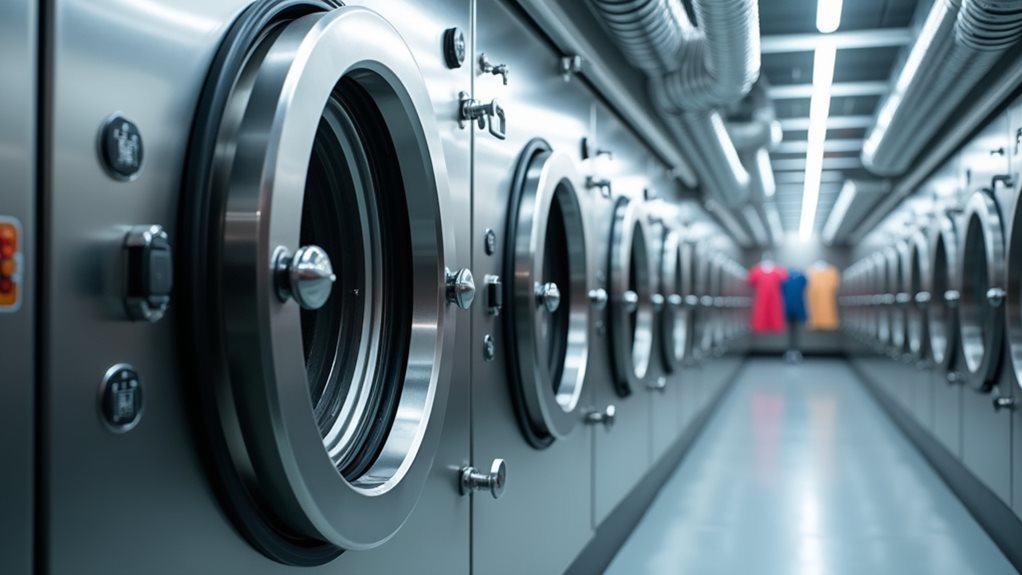
Five essential steps transform your stained garments from fashion disasters back into wardrobe favorites, and honestly, watching this process unfold feels a bit like witnessing fabric resurrection in action.
First, garment inspection begins when professionals examine every inch of your clothes, tagging them for proper tracking—think of it as creating a personalized roadmap for each piece.
Every garment gets its own detailed inspection and tracking tag—like a personalized passport through the cleaning journey.
Next, visible stains get pre-treated with specialized formulas that target specific culprits like wine or grease.
Then comes the main event: your clothes enter large machines where chemical solvent circulates, dissolving dirt and oils without water damage.
Finally, after drying in the same machine, another inspection guarantees quality before packaging.
The dry cleaning process recovers 99.99% of solvent, making it surprisingly eco-friendly! 🌿
This gentle yet effective cleaning method is essential for maintaining luxury fabrics that would be damaged by traditional water-based washing.
Solvents Used in Dry Cleaning

Chemistry becomes the unsung hero of your wardrobe when we explore the fascinating world of dry cleaning solvents, and trust me, understanding these liquid magicians will completely change how you think about that “dry clean only” label.
Perchloroethylene has dominated the industry since the 1930s, though it’s like that reliable friend who mightn’t be the healthiest influence.
Today’s dry cleaning solvents are evolving toward safer alternatives that’ll make you breathe easier—literally.
- Perchloroethylene (PCE) – The traditional powerhouse that’s incredibly effective but carries health concerns
- High flash hydrocarbons – Safer alternatives that clean beautifully without the toxic baggage
- Liquid CO2 – The eco-warrior of solvents, using pressurized carbon dioxide
- Glycol ethers – Emerging environmentally friendly solvents that’re gentler on everything
- Supercritical CO2 – Space-age technology that transforms carbon dioxide into cleaning magic ✨
The key properties that make effective dry cleaning solvents include non-flammability, chemical stability, and the ability to dissolve oils and greases while being gentle on delicate fabrics.
Understanding these options empowers you to choose cleaners aligned with your values.
Types of Fabrics That Require Dry Cleaning

You’ll discover that certain fabrics practically beg for professional care, and trust me, I learned this the hard way after shrinking my favorite wool sweater into doll-sized proportions 😅.
When you’re dealing with delicate natural fibers like silk, wool, and cashmere, or those gorgeous structured formal garments that need to maintain their crisp lines, dry cleaning becomes your fabric’s best friend.
Special occasion pieces with intricate beadwork, sequins, or other embellishments also require this gentle treatment, since water and regular detergents can turn your stunning evening gown into a craft project gone wrong.
Additionally, garments with special dyes that might bleed or deteriorate need the protection of chemical solvents rather than water-based cleaning methods.
Delicate Natural Fibers
Elegance comes with a price, and that price often means a trip to the dry cleaner when you’re dealing with delicate natural fibers that simply can’t handle the rough-and-tumble world of your washing machine.
I learned this lesson the hard way after accidentally shrinking my favorite cashmere sweater into doll clothes – trust me, you don’t want to repeat my mistake!
These luxurious materials need the gentle touch of dry cleaning solvent to maintain their beauty and longevity.
Why delicate natural fibers require special care:
- Silk loses its lustrous shine when exposed to water and agitation
- Wool can shrink dramatically and become misshapen in regular washing
- Cashmere fibers become matted and lose their soft texture
- Water damages the protein structure in these natural materials
- Dry cleaning effectively removes oil-based stains without compromising fiber integrity
Beyond protecting the fabric structure itself, dry cleaning helps preserve the color and texture of these premium materials while preventing the fading and deterioration that commonly occurs with traditional washing methods.
Structured Formal Garments
Envision this: you’re getting ready for that important job interview or wedding, and you reach for your go-to blazer only to discover it’s wrinkled, stained, and somehow smells like last month’s networking event – this is exactly when you’ll appreciate the magic of dry cleaning for structured formal wear.
Your suits, evening gowns, and customized pieces are delicate investments that deserve special treatment, and that’s where your local dry cleaners place becomes your best friend.
These garments often feature wool, silk, or intricate beadwork that water would absolutely destroy, which is why the specialized cleaning process that uses chemical solvents instead of water keeps everything pristine and perfectly shaped for life’s most important moments.
Garments with complex linings or multiple fabric types also benefit from professional dry cleaning to maintain their structural integrity and prevent damage from the agitation of conventional washing machines.
Embellished Special Items
Beyond the classic suit jackets and evening wear, there’s an entire world of show-stopping pieces that’ll make your regular washing machine throw up its hands in defeat – I’m talking about those gorgeous embellished garments that sparkle, shimmer, and steal the spotlight at every special occasion.
These delicate materials demand the gentle touch that only dry cleaning can provide, where specialized solvents used in dry cleaning work their magic without the harsh mechanical agitation of water washing.
- Intricate beading that could scatter like confetti in a regular wash
- Sequined party dresses that need their sparkle preserved
- Hand-embroidered silk pieces with cultural significance
- Velvet evening gowns that water would absolutely ruin
- Designer pieces with mixed fabric construction
The dry cleaning process also eliminates the risk of color bleeding and fabric distortion that can occur with conventional washing methods.
Trust me, investing in proper dry cleaning for these treasures beats replacing them!
Benefits and Limitations of Dry Cleaning
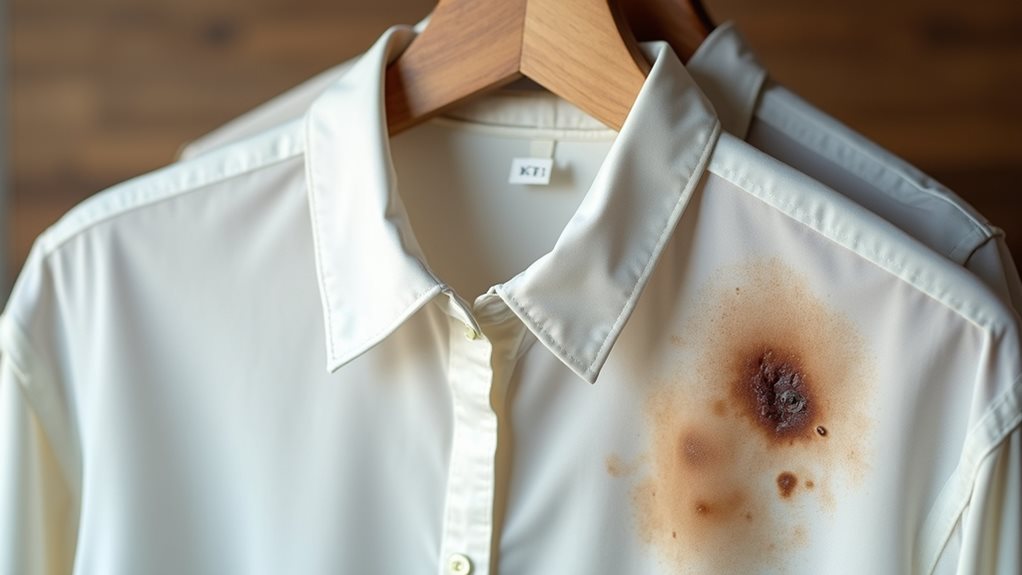
When you’re deciding whether to drop off that expensive silk blouse at the dry cleaner, you’ll want to understand both the impressive benefits and frustrating limitations that come with this specialized cleaning process.
While dry cleaning can work magic on oil-based stains and preserve delicate fabrics like they’re precious heirlooms, it also comes with drawbacks like higher costs and potential risks to certain embellished garments that might leave you second-guessing your choice.
The process uses chemical solvents instead of water to remove stains and dirt, making it particularly effective for materials that cannot withstand traditional washing methods.
I’ve learned the hard way that knowing these trade-offs upfront saves you from both wardrobe disasters and wallet surprises, especially when you’re standing at the counter holding a garment you’re not sure about 😅.
Key Dry Cleaning Benefits
Precision becomes your greatest ally when you’re dealing with those special garments that make you feel absolutely incredible, and dry cleaning offers a level of care that regular washing simply can’t match.
The dry cleaning industry has perfected techniques that’ll protect your investment while delivering results you can actually see and feel.
Here’s what makes dry cleaning genuinely worth your time and money:
- Fabric preservation – Your silk blouses and cashmere sweaters maintain their original texture, shape, and vibrant colors
- Superior stain removal – Solvents used in dry cleaning dissolve oil-based stains that water-based detergents can’t touch
- Hygiene improvement – High heat and chemical processing eliminate bacteria and viruses from your clothing
- Professional expertise – Cleaning and textile specialists handle delicate materials with specialized knowledge
- Convenience factor – You’ll save time while guaranteeing professional-quality results every single visit
Professional pressing and finishing services ensure your tailored items like suits and formal wear maintain their crisp structure and polished appearance.
Process Drawbacks and Risks
While dry cleaning delivers remarkable results for your favorite garments, it’s not without its fair share of limitations and potential risks that you’ll want to understand before dropping off your next load.
Those powerful chemical solvents that work magic on oil stains? They’re surprisingly useless against water-based mishaps like sweat marks or juice spills, leaving you disappointed and still stained.
Even more concerning, dry cleaning machines using traditional perchloroethylene create serious health and environmental concerns, with studies linking prolonged exposure to respiratory issues and groundwater contamination.
I’ve learned the hard way that certain fabrics—think sequined party dresses or plastic-trimmed athletic wear—can actually melt or warp in those chemical baths, turning your treasured pieces into expensive mistakes.
Additionally, PERC can pose risks to customers who wear freshly cleaned garments, as the chemical may linger in fabrics and cause neurological symptoms from exposure.
Health and Environmental Considerations
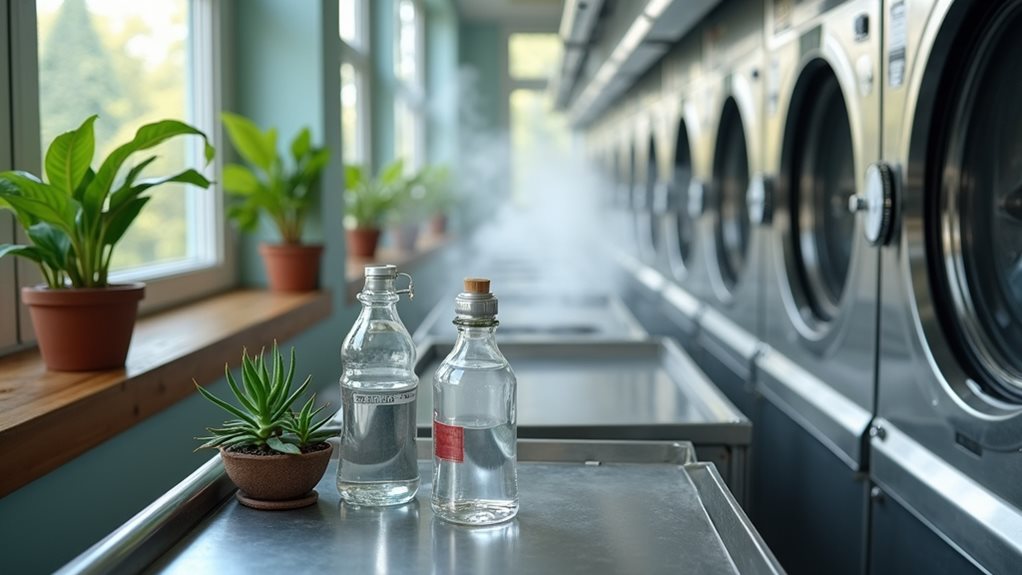
Although I’ve always trusted my neighborhood dry cleaner with my favorite wool coat, I’d no idea that the chemicals swirling around those machines could pose serious health risks until my friend Sarah, who worked at a cleaning facility for years, started experiencing persistent headaches and fatigue.
Like many customers, I blindly trusted my local dry cleaner until learning about the hidden health dangers lurking behind their chemical processes.
The culprit? Perchloroethylene, or “perc,” the industry’s go-to solvent that’s now being phased out due to cancer concerns.
Here’s what you should know about dry cleaning’s environmental concerns:
- Chemical leakage can contaminate nearby soil and groundwater
- Air quality suffers from solvent emissions around facilities
- Worker exposure causes headaches, dizziness, and potential long-term health issues
- EPA regulations banned perc in residential areas by 2020
- Alternative solvents like liquid CO2 offer safer cleaning options
The good news? Many cleaners are embracing eco-friendly methods.
Maximizing Your Dry Cleaning Experience

Getting the most from your dry cleaning investment requires more strategy than simply dropping off a wrinkled blazer and hoping for the best, something I learned the hard way after my favorite silk blouse came back with a mysterious new stain that wasn’t there before.
Communication becomes your secret weapon here – tell your cleaner exactly what caused that wine spill or grease mark, because dry cleaners use different treatments for different stains.
When your garments are cleaned without this vital information, even the best stain remover might fail spectacularly.
I’ve discovered that mentioning delicate beading, previous cleaning attempts, or fabric sensitivities creates a partnership rather than just a transaction, resulting in clothes that look better and last longer than ever.

